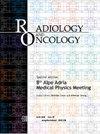Predictive potential of dynamic contrast-enhanced MRI and plasma-derived angiogenic factors for response to concurrent chemoradiotherapy in human papillomavirus-negative oropharyngeal cancer.
IF 2.2
4区 医学
Q3 ONCOLOGY
引用次数: 0
Abstract
BACKGROUND Dynamic contrast-enhanced magnetic resonance imaging (DCE-MRI) can assess tumour vascularity, which depends on the process of angiogenesis and affects tumour response to treatment. Our study explored the associations between DCE-MRI parameters and the expression of plasma angiogenic factors in human papilloma virus (HPV)-negative oropharyngeal cancer, as well as their predictive value for response to concurrent chemoradiotherapy (cCRT). PATIENTS AND METHODS Twenty-five patients with locally advanced HPV-negative oropharyngeal carcinoma were prospectively enrolled in the study. DCE-MRI and blood plasma sampling were conducted before cCRT, after receiving a radiation dose of 20 Gy, and after the completion of cCRT. Perfusion parameters ktrans, kep, Ve, initial area under the curve (iAUC) and plasma expression levels of angiogenic factors (vascular endothelial growth factor [VEGF], connective tissue growth factor [CTGF], platelet-derived growth factor [PDGF]-AB, angiogenin [ANG], endostatin [END] and thrombospondin-1 [THBS1]) were measured at each time-point. Patients were stratified into responders and non-responders based on clinical evaluation. Differences and correlations between measures were used to generate prognostic models for response prediction. RESULTS Higher perfusion parameter ktrans and higher plasma VEGF levels successfully discriminated responders from non-responders across all measured time-points, whereas higher iAUC and higher plasma PDGF-AB levels were also discriminative at selected time points. Using early intra-treatment measurements of ktrans and VEGF, a predictive model was created with cut-off values of 0.259 min-1 for ktrans and 62.5 pg/mL for plasma VEGF. CONCLUSIONS Early intra-treatment DCE-MRI parameter ktrans and plasma VEGF levels may be valuable early predictors of response to cCRT in HPV-negative oropharyngeal cancer.动态对比增强磁共振成像和血浆衍生血管生成因子对人类乳头瘤病毒阴性口咽癌同期化放疗反应的预测潜力。
背景动态对比增强磁共振成像(DCE-MRI)可评估肿瘤血管性,而肿瘤血管性取决于血管生成过程并影响肿瘤对治疗的反应。我们的研究探讨了人乳头状瘤病毒(HPV)阴性口咽癌中 DCE-MRI 参数与血浆血管生成因子表达之间的关联,以及它们对同期化放疗(cCRT)反应的预测价值。在 cCRT 前、接受 20 Gy 放射剂量后和 cCRT 结束后分别进行了 DCE-MRI 和血浆采样。在每个时间点测量灌注参数ktrans、kep、Ve、初始曲线下面积(iAUC)和血浆中血管生成因子(血管内皮生长因子[VEGF]、结缔组织生长因子[CTGF]、血小板衍生生长因子[PDGF]-AB、血管生成素[ANG]、内生长因子[END]和凝血酶原-1[THBS1])的表达水平。根据临床评估将患者分为应答者和非应答者。结果在所有测量时间点上,较高的灌注参数 ktrans 和较高的血浆 VEGF 水平能成功区分有反应者和无反应者,而较高的 iAUC 和较高的血浆 PDGF-AB 水平也能在选定的时间点上区分有反应者和无反应者。结论早期治疗期间的 DCE-MRI 参数 ktrans 和血浆 VEGF 水平可能是 HPV 阴性口咽癌患者对 cCRT 反应的早期预测指标。
本文章由计算机程序翻译,如有差异,请以英文原文为准。
求助全文
约1分钟内获得全文
求助全文
来源期刊

Radiology and Oncology
ONCOLOGY-RADIOLOGY, NUCLEAR MEDICINE & MEDICAL IMAGING
CiteScore
4.40
自引率
0.00%
发文量
42
审稿时长
>12 weeks
期刊介绍:
Radiology and Oncology is a multidisciplinary journal devoted to the publishing original and high quality scientific papers and review articles, pertinent to diagnostic and interventional radiology, computerized tomography, magnetic resonance, ultrasound, nuclear medicine, radiotherapy, clinical and experimental oncology, radiobiology, medical physics and radiation protection. Therefore, the scope of the journal is to cover beside radiology the diagnostic and therapeutic aspects in oncology, which distinguishes it from other journals in the field.
 求助内容:
求助内容: 应助结果提醒方式:
应助结果提醒方式:


